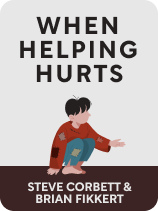

This article is an excerpt from the Shortform book guide to "When Helping Hurts" by Steve Corbett and Brian Fikkert. Shortform has the world's best summaries and analyses of books you should be reading.
Like this article? Sign up for a free trial here.
What are the different types of aid? Are you providing the right type of relief aid?
According to Steve Corbett and Brian Fikkert in their book When Helping Hurts, there are three types of aid: relief, rehabilitation, and development. It’s important to choose what type of aid you need to provide before starting a poverty-alleviation project.
Below, we’ll look at the authors’ three types of aid plus how other organizations categorize aid.
Provide the Right Type of Aid
As you prepare for a poverty-alleviation project, one of the first things you need to decide is what kind of aid to provide. The authors explain that there are three basic types of aid:
Relief consists of providing immediate assistance to people in a time of crisis, such as when their homes have been demolished by an earthquake, or they’ve had to flee their homes because of war. When correctly applied, relief temporarily provides outside resources to prevent a bad situation from getting worse.
Rehabilitation consists of helping people to recover from a crisis. According to Corbett and Fikkert, rehabilitation should take the place of relief as soon as the victims of the crisis no longer need urgent material assistance to prevent their situation from worsening. A key distinction between relief and rehabilitation is that relief is characterized by giving things to people, whereas rehabilitation involves working with people to help them recover. Rehabilitation efforts should end when recovery is complete, that is, when the crisis victim has recovered to where they were before the crisis struck.
Development consists of empowering people to improve their situation beyond what it’s been in the past. Development picks up where rehabilitation leaves off. The authors assert that development should involve a two-way relationship where both the provider and receiver help each other mend their broken relationships with God, self, others, and creation.
For example, suppose your neighbor’s house was destroyed by a tornado. Letting him stay in your guest bedroom, free of charge, for a while is relief. Lending a hand as he rebuilds his house is rehabilitation. Spending time strategizing with him about how you can both be better prepared for the next tornado season is development.
Don’t Provide Relief to People Who Need Development
Corbett and Fikkert advise that it’s important to consider which of the three types of aid the community you’re trying to help actually needs and provide the right type of aid. They observe that many churches default to providing relief, but most poor people need development, not relief.
At any given time, only a small percentage of the poor people in the world need immediate relief: victims of recent natural disasters, for example. But even in the case of a natural disaster, the authors observe that by the time a church has heard about the disaster on the news, planned a charitable mission to help the victims, raised funding to support the mission, and sent a missionary team to the affected area, the need for relief is typically over. By that time the victims need rehabilitation or development.
Moreover, as the authors explain, providing relief to people who really need rehabilitation or development may only delay their progress. If they receive short-term relief but never get the rehabilitation and development that they need, then when the relief ends, their situation may become worse than ever
Systems of Classifying Aid
Corbett and Fikkert are often credited with originating the classification of aid into relief, rehabilitation, and development. While this system of classifying aid is widely used, some organizations, such as Habitat for Humanity and the US Agency for International Development (USAID), use a slightly different and more complex system. It’s important to clearly distinguish which system a given source is using because different systems use some of the same terms to mean different things.
Instead of dividing aid into relief, rehabilitation, and development, the USAID system divides aid into relief, development, and institutionalization, and further subdivides each of these categories. Under this system:
Relief is the first stage of crisis response, and consists of three consecutive parts: First, “emergency response” consists of providing food, clothing, medical attention, and so forth to disaster victims. Second, “transitional shelter” consists of providing some kind of temporary lodging to protect victims from the elements. This could mean putting them up in hotels or public housing, if available, or it could mean giving them tents or similar temporary shelters. Third, “repair” consists of helping them salvage what can be salvaged in the aftermath of the disaster and restore infrastructure that was damaged but can readily be restored to working order.
This definition of “relief” is similar to Corbett and Fikkert’s, but slightly broader. They would probably consider the “repair” stage to be rehabilitation rather than relief.
Development is the second stage of crisis response in the USAID system. The first substage of development is “rehabilitation,” which in this system consists of getting essential local services (like water distribution) back up and running. The second substage of development is “rebuilding,” which encompasses the whole process of working with the locals to rebuild homes and infrastructure to the point where they are livable again after the disaster. The system identifies “reconstruction” as a subpart of “rebuilding” that focuses on the actual construction activities, while other aspects of “rebuilding” include assessing the damage, planning, and training the locals in construction skills.
Since “development,” as defined by USAID, is still part of the process to get back to pre-crisis infrastructure, Corbett and Fikkert would consider this work part of rehabilitation, not development. The only exception might be the training that the locals receive, if it has the potential to help them progress beyond their pre-crisis state.
Institutionalization involves moving away from direct involvement in reconstruction toward indirect involvement, like providing financial services to local construction agencies and training locals in finance and construction management.
Again, Corbett and Fikkert consider some of these training activities part of “development” in their system, and the emphasis on increased responsibility of the locals for their own success at the institutionalization phase also resembles their description of “development.” But in USAID’s system, the purpose of institutionalization is still primarily to get the community back to where it was before the crisis, so in Corbett and Fikkert’s system, “institutionalization” would still consist mostly of rehabilitation.
The Rising Need for Relief
Some sources might contest Corbett and Fikkert’s assertion that efforts to help the poor need to shift away from relief toward rehabilitation and development on the grounds that the increasing frequency of natural disasters is increasing the demand for relief.
This perspective exists in both secular and Christian circles, although secular sources generally attribute the increasing frequency of natural disasters to human-caused climate change, while Christian sources often attribute it to the impending end of the world, as Christ prophesied in Matthew 24:3-8.
However, the increased need for relief doesn’t lessen the importance of providing the right kind of aid in any given situation, nor does it reduce the global demand for rehabilitation and development.

———End of Preview———
Like what you just read? Read the rest of the world's best book summary and analysis of Steve Corbett and Brian Fikkert's "When Helping Hurts" at Shortform.
Here's what you'll find in our full When Helping Hurts summary:
- How many Christian church missions actually do more harm than good
- A look into the true nature and causes of poverty
- Suggestions for how to help the poor more effectively






